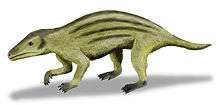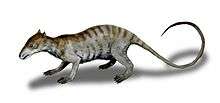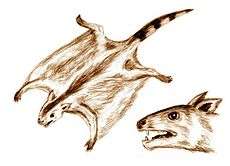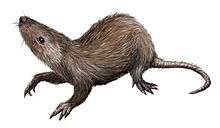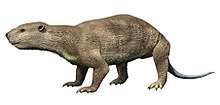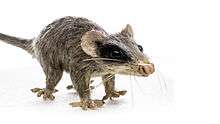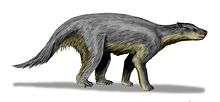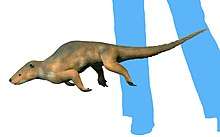Necrolestes
Necrolestes ("grave robber" or "thief of the dead") is an extinct genus of non-therian mammals, which lived during the Early Miocene in what is now Argentine Patagonia. It contains two species, N. patagonensis and N. mirabilis, and is the most recent known genus of dryolestoid. The type species N. patagonensis was named by Florentino Ameghino in 1891 based on remains found by his brother, Carlos Ameghino in Patagonia. Fossils of Necrolestes have been found in the Sarmiento and Santa Cruz Formations.[2]
| Necrolestes | |
|---|---|
 | |
| N. patagonensis reconstructed as a mole-like animal | |
| Scientific classification | |
| Kingdom: | Animalia |
| Phylum: | Chordata |
| Class: | Mammalia |
| Superorder: | †Dryolestoidea |
| Clade: | †Meridiolestida |
| Family: | †Necrolestidae Ameghino, 1891[1] |
| Genus: | †Necrolestes Ameghino, 1891 |
| Type species | |
| Necrolestes patagonensis Ameghino, 1891 | |
| Species | |
| |
Description
.jpg)
About one-third of the skeleton of N. patagonensis—including most of the skull— has been found as disassociated bones of several individuals. The jaw bends up at the tip, possibly supporting a fleshy appendage similar to the sensitive tentacles of the star-nosed mole. Necrolestes is also sometimes reconstructed as a mole-like creature. It probably fed on insects or worms.[3]
Classification
Its classification is not firmly resolved due to it being highly apomorphic and having an anatomy unlike any other known mammal, living or extinct. It was thought to be a therian mammal; placement within either the marsupial lineage (Metatheria) or as a member of Eutheria would have been possible given that South America as an island had extensive lineages of both marsupial and placental mammals. However, phylogenetic analyses conducted by Rougier et al. (2012), Chimento, Agnolin and Novas (2012) and Averianov, Martin and Lopatin (2013) recovered Necrolestes in an unexpected phylogenetic position as a nontherian mammal that belonged to the clade Meridiolestida;[4][5][6] if confirmed this would make Necrolestes the youngest known member of the group. Within Meridiolestida, Rougier et al. (2012) found Necrolestes to be particularly closely related to the genera Cronopio and Leonardus;[4] Chimento et al. (2012) found it to be in unresolved polytomy with Cronopio, Leonardus and the clade containing all other meridiolestidans[5] while Averianov et al. (2013) recovered Cronopio, Necrolestes and Leonardus as forming a grade at the base of Meridiolestida rather than a clade.[6]
Meridiolestidans themselves were initially classified as member of the clade Dryolestida;[7] this result was confirmed by the analysis of Chimento et al. (2012),[5] while Rougier et al. (2012) recovered them as slightly more closely related to the placental mammals, marsupials and amphitheriids than the members of Dryolestida were,[4] and Averianov, Martin and Lopatin (2013) recovered meridiolestidans as the sister group of spalacotheriid "symmetrodonts".[6] However, various subsequent studies have consistently shown a dryolestoid identity for meridiolestidans.[8][9][10]
Phylogeny
This cladogram follows the paper of Rougier, Wible, Beck and Apesteguía of 2012:[4]
| Meridiolestida |
| ||||||||||||||||||||||||||||||||||||
References
- Florentino Ameghino (1891). "Nuevos restos de mamíferos fósiles descubiertos por Carlos Ameghino en el Eoceno inferior de la Patagonia austral. Especies nuevas, adiciones y correciones". Revista Argentina de Historia Natural. 1: 289–328.
- Necrolestes at Fossilworks.org
- Palmer, D., ed. (1999). The Marshall Illustrated Encyclopedia of Dinosaurs and Prehistoric Animals. London: Marshall Editions. p. 204. ISBN 978-1-84028-152-1.
- Guillermo W. Rougier, John R. Wible, Robin M. D. Beck and Sebastian Apesteguía (2012). "The Miocene mammal Necrolestes demonstrates the survival of a Mesozoic nontherian lineage into the late Cenozoic of South America". Proceedings of the National Academy of Sciences of the United States of America. 109 (49): 20053–20058. doi:10.1073/pnas.1212997109. PMC 3523863. PMID 23169652.CS1 maint: uses authors parameter (link)
- Nicolás R. Chimento, Federico L. Agnolin and Fernando E. Novas (2012). "The Patagonian fossil mammal Necrolestes: a Neogene survivor of Dryolestoidea" (PDF). Revista del Museo Argentino de Ciencias Naturales, Nueva Serie. 14 (2): 261–306. Archived from the original (PDF) on 2013-11-04. Retrieved 2017-08-08.
- Alexander O. Averianov, Thomas Martin and Alexey V. Lopatin (2013). "A new phylogeny for basal Trechnotheria and Cladotheria and affinities of South American endemic Late Cretaceous mammals". Naturwissenschaften. 100 (4): 311–326. doi:10.1007/s00114-013-1028-3. PMID 23494201.CS1 maint: uses authors parameter (link)
- Guillermo W. Rougier, Sebastián Apesteguía and Leandro C. Gaetano (2011). "Highly specialized mammalian skulls from the Late Cretaceous of South America". Nature. 479 (7371): 98–102. doi:10.1038/nature10591. PMID 22051679.CS1 maint: uses authors parameter (link) Supplementary information
- Agnolin, F.; Chimanto, N. (2014-12-22). "Morphological evidence supports Dryolestoid affinities for the living Australian marsupial mole Notoryctes". PeerJ Preprints. 2: e755v1. doi:10.7287/peerj.preprints.755v1. Retrieved 2015-12-30.
- Agustin G. Martinelli, Laura Chornogubsky, María Alejandra Abello, Marcelo A. Reguero, The first non-therian dryolestoid from Antarctica Conference Paper · August 2014 DOI: 10.13140/2.1.2770.8805 Conference: 2014 SCAR Open Science Conference, At Auckland, New Zealand, Volume: Abstracts Volume
- Richard Stephen Thompson, Rachel O'Meara, Were There Miocene Meridiolestidans? Assessing the Phylogenetic Placement of Necrolestes patagonensis and the Presence of a 40 Million Year Meridiolestidan Ghost Lineage, Article in Journal of Mammalian Evolution · September 2014 DOI: 10.1007/s10914-013-9252-3

